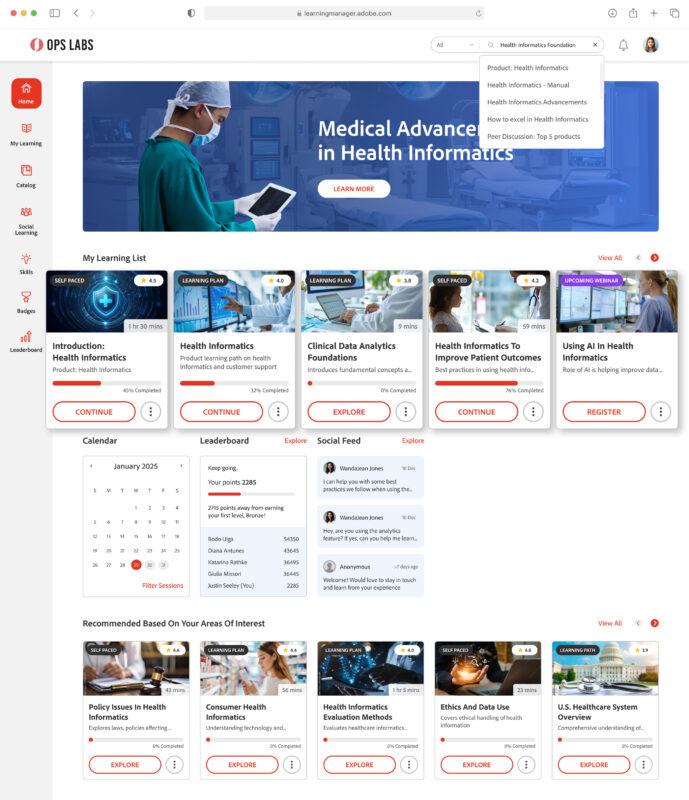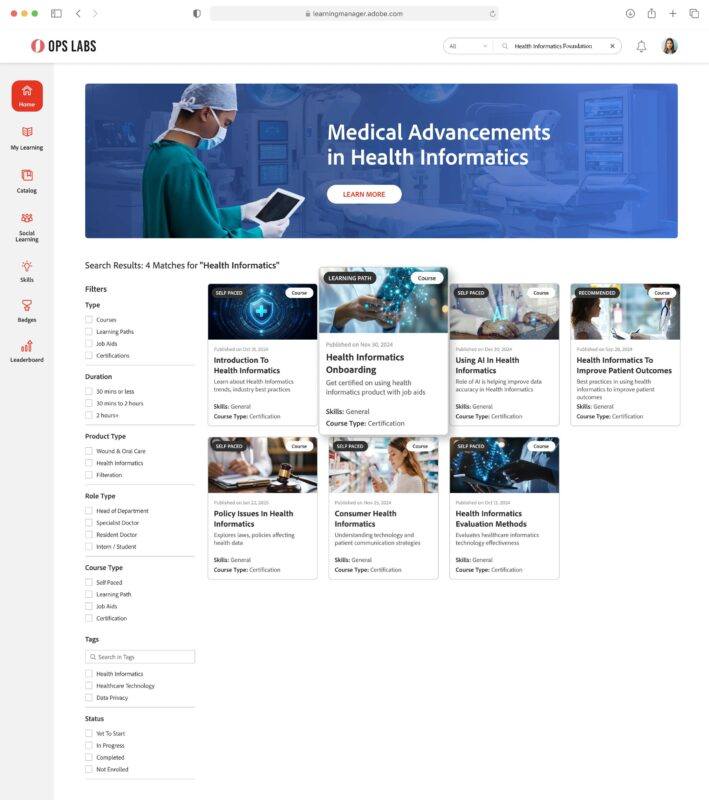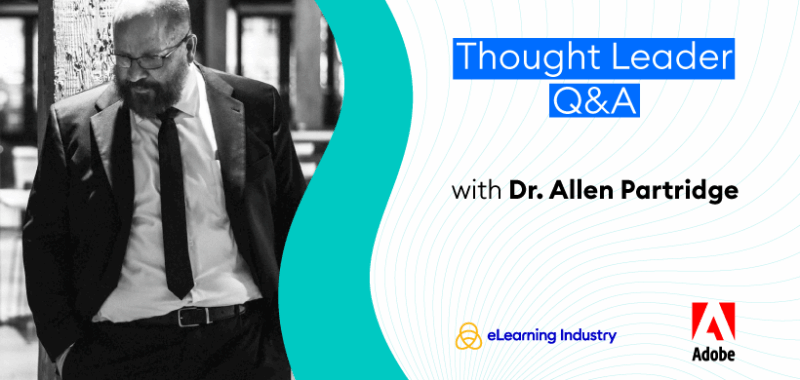Exploring The Possibilities Of Agentic Learning With An eLearning Trailblazer
Dr. Allen Partridge is Adobe’s Director of Digital Learning Evangelism, celebrated for his dynamic public speaking and insightful writing on immersive learning, gamification, and AI-enhanced education. His PhD in Interdisciplinary Studies uniquely integrates art, music, theater, philosophy, and computer science, reflecting the rare intersection of creativity, technological fluency, and deep critical thinking. Dr. Partridge’s rich academic and professional journey positions him perfectly at the nexus of specialized knowledge and AI technology, embodying the sought-after unicorn skillset essential for driving innovation and effective collaboration in today’s evolving knowledge workforce. Today, he speaks with us about AI’s role in content creation and curation, agentic learning, and which emerging tech features organizations should look for in their next LMS.
Based on your experience, how can L&D teams use AI to drive efficiency at every stage of creation, curation, and delivery?
AI’s greatest strength in L&D today is as an accelerator—not a disruptor. Rather than upending established workflows, AI can enhance them: speeding content creation, sharpening search and discovery, and optimizing delivery across learner groups. One global enterprise used Adobe Learning Manager’s AI recommendations to train 36,000+ staff with 20% less admin overhead—without changing its core strategy. Another scaled certification across 900+ locations by personalizing delivery through AI, increasing reach while reducing operational friction. Below is a hypothetical healthcare company, Ops Labs, that sells a health informatics solution to specialist doctors. AI recommendations can help recommend courses based on area of interest, popularity of course, etc.

This kind of enhancement can touch every stage of the learning cycle. AI can assist with writing, build learning paths dynamically based on user behavior, and surface data-driven insights to support administrators. The result is faster delivery, more relevant learning, and better decisions without reinventing the wheel.
Can you tell us a bit more about agentic learning and how it can help organizations boost productivity and empower L&D pros?
Agentic learning refers to an emerging AI model where autonomous agents act on behalf of the learner, adjusting the experience in real time based on goals, behavior, and context. It’s a shift from static learning journeys to something more dynamic and responsive. Picture a forest of small, specialized assistants—one surfacing timely resources, another nudging a user toward mastery, another suggesting next steps based on observed progress.
While still on the horizon for many, the potential is compelling. These agents could reduce the need for constant manual curation and give learners more autonomy, both of which help L&D teams scale without sacrificing relevance. We’re seeing early explorations of this concept in adaptive recommendations and role-aware learning paths, and platforms like Adobe Learning Manager are evolving to support these kinds of intelligent, learner-centered experiences.
One of the features we are rolling out in beta is an Admin AI Assistant to elevate the L&D admin’s self-service experience. The AI-powered assistant is designed to provide instant and accurate responses to your common queries and troubleshoot issues on the platform without referring to lengthy documentation or dependency on our support teams.

What is one of your standout client success stories that highlights the power of AI and human collaboration?
Two examples come to mind—very different organizations, but they underscore how AI can extend human capacity without replacing it.
A global airline, operating through a vast franchise model, needed to train tens of thousands of staff across dispersed regions. Their L&D team used Adobe Learning Manager to integrate AI-powered content recommendations into their platform, surfacing the most relevant materials for each learner based on role, activity, and geography. The strategy was still human-led: Instructional Designers set the goals and chose the resources. But AI helped route that content more intelligently, reducing administrative overhead by 20% while increasing engagement across the network.
In the healthcare sector, a leading prosthetics manufacturer faced the challenge of educating both clinicians and patients at scale. By consolidating multiple platforms into Adobe Learning Manager, they were able to deliver personalized certification pathways powered by AI—matching content to each learner’s role and need. With human oversight guiding program design, AI played a supporting role: fine-tuning search, customizing delivery, and surfacing the right learning at the right time across more than 900 clinics.
In both cases, the story wasn’t about replacing people—it was about empowering them. AI helped extend reach, speed up delivery, and personalize at scale while letting human experts focus on quality, context, and care.
What are some of the AI-focused features that organizations should have on their must-have list when looking for a new Learning Management System? How can these functionalities personalize learning and increase engagement?
It’s tempting to chase a checklist of AI features, but the real opportunity lies in how AI is embedded throughout the learning experience, not just in one tool or workflow. The best LMS platforms don’t bolt AI on the side; they use it to accelerate content creation, personalize learning paths, support skills growth, and streamline operations—all without disrupting trusted processes.
Organizations should look for solutions that smooth the transition from recruitment to onboarding, helping new hires get up to speed quickly through automated, role-aware journeys. AI can assist learners in identifying skill gaps, planning their careers, and tracking progress with minimal friction. Tools like headless delivery and open APIs support seamless integration with enterprise systems while enabling deeply branded experiences.
AI-enhanced search and recommendation features help surface relevant content, while conversational tools (like an AI buddy or coach) offer microlearning moments and context-sensitive support. Peer-based recommendation models, refreshed catalogs, and dynamic learning paths help maintain relevance over time.
Let’s use the same hypothetical healthcare customer, Ops Labs. They implemented AI-powered search for the doctors. As you will see in the image below, if a user types “Health Informatics Foundation”, the system understands the term’s “Health Informatics” as the more important keywords, and search results will show all relevant courses that include basics or fundamentals of “Health Informatics”.

Engagement is further driven by gamification, social recognition, and user-generated content, creating a two-way learning culture. And for administrators, integrations with HRMS, performance systems, and powerful data visualization tools allow for real-time insight into learning application and business impact.
Ultimately, AI’s value in an LMS isn’t in its novelty—it’s in how quietly and effectively it supports people, from learners to L&D leaders, at every turn.
How do you think the role of generative AI in learning will expand or evolve in the coming years?
In the near future, generative AI won’t just help create content—it’ll maintain and evolve it, becoming a kind of co-author and silent editor-in-residence. Imagine an AI that knows every course you’ve ever launched, reviews your old materials, and quietly suggests updates based on emerging skills frameworks, business strategy shifts, or even breaking news. Your learning library stays current without you lifting a finger.
We’re also on the cusp of more proactive learning agents—tools that monitor context (your calendar, a headline, a product recall) and surface just-in-time training before a critical meeting. Combine that with a forest of intelligent assistants embedded in your ecosystem, and L&D shifts from reactive to anticipatory.
Over time, generative AI will evolve into a reflective design partner—one that helps learners grow, helps designers stay sharp, and helps organizations build learning ecosystems that are as alive and adaptive as the people they serve.
Wrapping Up
We’d like to thank Dr. Allen Partridge for shedding more light on the potential of agentic AI in learning and how the right LMS can transform L&D experiences. If you’d like to learn more about Adobe’s AI capabilities, check out their ultimate list of features.

